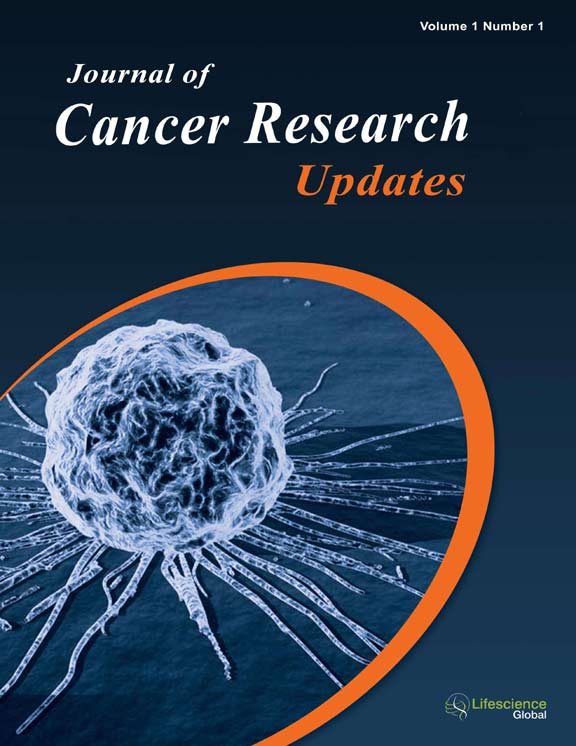jcru
Abstract : Short Communication: Studying the Role of Smart Flare Gold Nano Particles in Studying Micro RNA and Oncogene Differential Expression in Prostate Cancer Cell Lines
|
|
Abstract: Nano technology is a cutting edge science which is now effectively used in the field of cancer biology. Smart Flare gold nanoparticles are now used often for differential gene expression analysis. In this manuscript we are reporting the use of micro RNA miR 146a and onco gene EZH2 Smart Flare probes to study their expression in different prostate cancer cell lines and the effect of novel Rhenium compounds on these genes using a flow cytometer and a Fluorescence microscope. Our results showed this novel nanotechnology can be effectively used in cancer biology to successfully detect the effect of novel drugs on oncogenes and could be a very useful tool for next generation of cancer researchers. Keywords: Nanoparticles, micro RNA, gene expression. Download Full Article |
Abstract : Isoniazid Induced Toxicities and Idiosyncratic Responses in Male Albino Wistar Rats
|
|
Abstract: Isoniazid (INH) is an anti-tuberculosis drug administered over a long period. Upon metabolism in the liver, INH generates nitrogen-centered radicals, reacting with cellular macromolecules, and induces toxic and transformational changes in cells and tissues. Here we examined the side effects of long-term (chronic) administration of isoniazid (2.5 and 5mg/kg) once daily for 30, 60 and 90 days consecutively: on hepatic transaminases, histological changes in hepatocytes and induction of micronuclei in the bone marrow and possible genotoxicity in E. coli PQ37. In addition, blood glucose was monitored during the various treatment period. Biochemical analysis of hepatic transaminases (γ -glutamyl-, alanine amino-, aspartate aminotransferases and alkaline phosphatase) in INH treated group was significantly (p<0.05) elevated as well as blood glucose level declined significantly (p<0.05) for both doses at 30, 60 and 90 treatment respectively. Total protein and albumin level decreased (p<0.05) at both treatment doses compared to control. Serum creatinine level significant (p<0.05) increased at days 30 and 60 relative to control. Antioxidants (GST, SOD and catalase) activity examined indicated a decrease in catalase levels which was significant (p<0.05) and an insignificant decrease (p>0.05) in GST in both treatment groups at day 60. There was also a significant increase (p<0.05) in the activity of superoxide dismutase activity. Micronucleus analysis further revealed an induction of micronucleated polychromatic erythrocytes (mPCEs), which was significant (p<0.05) for both treatment doses at days 30, 60 and 90 respectively. In addition, INH genotoxicity assessed by UMU chromotest indicated that the 5mg/kg dosage has an induction ratio above the genotoxicity threshold of 1.5 suggesting genotoxicity in E.coli PQ37. Taken together, INH treatment at both doses (2.5 and 5mg/kg body weight) was hepatotoxic and induced nephrotoxic damages, in addition to mutagenic effect which is more pronounced at 2.5mg/kg dose, thereby suggesting dose-dependent cellular and genetic toxicity. Keywords: Isoniazid, Tuberculosis, Mycobacterium tuberculosis, hepatotoxicity, genotoxicity, carcinogenesis. Download Full Article |
Abstract : Isolation of Chamuangone, a Cytotoxic Compound against Leishmania major and Cancer Cells from Garcinia cowa Leaves and its HPLC Quantitative Determination Method
|
|
Abstract: On the basis of a leishmanicidal assay-guided isolation, chamuangone was purified from Garcinia cowa leaves together with four inactive compounds; 5-hydroxymethylfurfural; D-glyceropentaric acid,2-deoxy-3-C-(methoxycarbonyl)-1,4-lactone,5-ethyl ester; isoorientin-6"-O-rhamnoside; and dulcinoside. Chamuangone possessed a cytotoxic activity against Leishmania major with an IC50 value of 10.7 µM, and also exhibited strong inhibitory activity against lung adenocarcinoma (SBC3 and A549) and leukemia (K562, and K562/ADM) cells with IC50 values of 6.5, 7.5, 3.8, and 2.2 µM, respectively. The HPLC method utilised a TSK-gel ODS-80Tm column with the mixture of acetonitrile and 2% phosphoric acid in water (97:3, v/v) as the mobile phase at a flow rate of 1 mL/min, and UV detection at 245 nm. The parameters of linearity, precision, accuracy, specificity and sensitivity of the method were evaluated. The recoveries of the method were 100.4-101.6% and good linearity (r2 ³ 0.9999) was obtained. A high degree of specificity, sensitivity and precision were also achieved.. Keywords: 5-hydroxymethylfurfural, D-glyceropentaric acid, 2-deoxy-3-C-(methoxycarbonyl)-1, 4-lactone, 5-ethyl ester, isoorientin-6"-O-rhamnoside, dulcinoside, method validation.. Download Full Article |
Abstract : Novel Structural Abnormalities Involving Chromosomes 1, 17 and 2 Identified by Fluorescence In Situ Hybridization (FISH) and/or Cytogenetic Karyotyping in Kelly and SH-SY5Y Human Neuroblastoma Cell Lines, Respectively
|
|
Abstract: MYCN amplification and 1p36 deletion are important poor prognostic factors in neuroblastoma. 1p36 deletion and unbalanced translocations involving chromosomes 1, 17 and 2p were often reported in neuroblastoma cell lines. We aimed to investigate novel chromosomal abnormalities that are likely to affect neuroblastoma progression in Kelly and SH-SY5Y cell lines. Therefore, we analyzed the metaphase chromosomes using fluorescence in situ hybridization (FISH) method with probes specific to the chromosome bands 2p24 and 1p36 in SH-SY5Y and Kelly, respectively. Moreover, the rearrangements of chromosomes 1 and 17 from Kelly were re-examined by cytogenetic karyotyping. FISH analysis shows duplication of chromosome 2p24 on the long arm of a partner chromosome resulted from an unbalanced translocation der(?9)t(2;?9)(p24;q?34) in SH-SY5Y, suggesting that duplication of 2p24 locus containing MYCN gene may contribute to triggering MYCN amplification in neuroblastoma. On the other hand, FISH and karyotype analyses reveal three copies of chromosome 1 that consist of an intact chromosome 1, an extra derivative chromosome 1 with terminal and interstitial deletions (:p32→q25::q41→qter), and another including only interstitial deletion (pter→q25::q41→qter), leading to monosomy of the long arm segment 1q25-q41 in Kelly. These results suggest that chromosome 1q25-q41 may contain one or more tumour suppressor genes important for neuroblastoma progression. Together, FISH analysis shows that an additional 1p36 locus in Kelly is translocated to the short arm of extra chromosome 17, where the p53 tumour suppressor gene is located. Consequently, these novel structural abnormalities involving chromosomes 1, 17 and 2 could be contributed to the tumourigenicity of neuroblastoma cells. Keywords: Kelly and SH-SY5Y human neuroblastoma cell lines, novel chromosomal abnormalities, MYCN amplification, duplication of chromosome 2p24, interstitial 1q deletion, terminal 1p36 deletion, t(1;17) translocation, fluorescence in situ hybridization (FISH), Cytogenetic Karyotyping. Download Full Article |






















